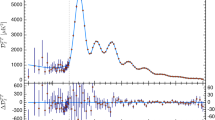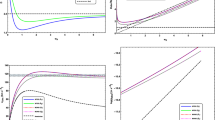Abstract
The Newtonian gravity force is massless and decreases as \(1/r^{2}\), too steeply to explain the flat rotation curves of spiral galaxies. Massive gravity, on the other hand, drops as \(1/r\) and is capable of doing the job. Massive fields have a respected record in the history of field theories. We follow the suit and add a ‘‘mass term’’ to the field equation of Newtonian gravity, which, to begin with, is static. Next, we use the observation-based Tully-Fisher relation to determine the nature and characteristics of the added mass term. We are able to produce the rotation curves flat enough to justify the observational data up to several optical radii of the galaxies, where observations are both abundant and reliable. At very far distances, however, massive gravity goes through a sequence of intermittently attractive and repulsive phases. This is a welcome novelty. It may enable one to address the wavy fluctuations and patchy voids that are not uncommon in the archives of observed rotation curves. With a stretch of imagination, massive gravity may find an observational support in the Oort clouds, a stipulated spherical shell of debris at farthest outreaches of the Solar system.





Similar content being viewed by others
REFERENCES
F. Zwicky, Helvetica Physica Acta 6, 110 (1933).
M. Fierz and W. Pauli, Proc. Roy. Soc. London A (Math. Phys.) 173, 211 (1939).
H. van Dam and M. Veltman, Nucl. Phys. B 22, 397 (1970).
V. I. Zakharov, JETP Lett. (USSR) (Engl. Transl.) 12, 312 (1970).
A. I. Vainshtein, Phys. Rev. B 39, 393 (1972).
D. G. Boulware and S. Deser, Phys. Rev. D 6, 3368 (1972).
C. de Rham and G. Gabadadze, Phys. Rev. D 82, 044020 (2010).
C. de Rham, G. Gabadadze, and A. J. Tolley, Phys. Rev. Lett. 106, 231101 (2011).
S. Hassan and R. A. Rosen, Phys. Rev. Lett. 108, 041101 (2011).
C. de Rham, http://www.phys.cwru.edu/ claudia/, 2015
S. L. Dubovsky, P. G. Tinyakov, and I. I. Tkachev, Phys. Rev. Lett. 94, 181102 (2005); hep-th/0411158.
E. A. Bergshoeff, O. Hohm, and P. K. Townsend, arXiv: 09051215.
E. Babichev, C. Defayet, and R. Ziour, arXiv: 0907.4103.
J. Oliva and S. Ray, arXiv: 1004.0737.
L. Parisi, N. Radicella, and G. Vilasi, arXiv: 1207.3922.
G. de Berredo-Peixoto, gr-qc/020802.
R. B. Tully and J. R. Fisher, Astron. Astroph. 54, 661 (1977).
M. Milgrom, Astroph. J. 270, 365 (1983).
R. H. Sanders and S. S. McGough, Ann. Rev. Astron. Astroph. 40, 263 (2002).
Y. Sobouti, Astroph. J. 464, 921 (2007).
H. C. Plummer, Mon. Not. R. Astron. Soc. 71, 460 (1911).
D. R. Clemens, Astroph. J. 295, 422 (1985).
Author information
Authors and Affiliations
Corresponding author
Rights and permissions
About this article
Cite this article
Sobouti, Y. Massive Gravity as an Alternative Gravity. Gravit. Cosmol. 26, 1–6 (2020). https://doi.org/10.1134/S0202289320010132
Received:
Revised:
Accepted:
Published:
Issue Date:
DOI: https://doi.org/10.1134/S0202289320010132




